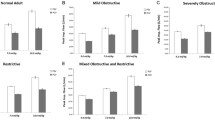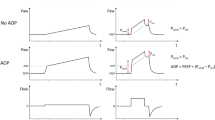Abstract
The effects of lung volume and respiratory airflow on airway resistance were studied in five anesthetized and paralyzed patients. Airway resistance measured during the inspiratory phase with intermittent constant airflow inflations decreased in inverse correlationship to increases in lung volume. Airway resistance measured during the expiratory phase with an airway interruption technique, on the other hand, increased with a linear relationship to the expiratory airflow as expressed by a function of =K1+ K2X. K1, calculated from the values of airway resistance corresponding to three different airflows, was unaffected by intentional expiratory resistance loading. Thus, simultaneously with the measurement of airway resistance by this method, expiratory gas sampling with a Douglas bag can be done if necessary. Since the K2 value of the endotracheal tube used in this study (PorteX® I.D. 8 mm, length 26 cm) was quite high (5.0 cmH2O·1−2·sec2), depending on the airflow, the presence of the endotracheal tube strongly affected the measurement of airway resistance during general anesthesia. K1 measured by the above method, however, may be considered as the best way to evaluate the lower airway resistance independent of either lung volume or expiratory airflow.
Similar content being viewed by others
References
Sakai T, Tanaka A, Takaori M: Effects of inhalation anesthetics on respiratory resistance in man. Jpn J Anesthesiol 28:377–382, 1979
Sakai T, Ohsumi A, Yano H, Takaori M: Effects of halothane and enflurane on the airway dynamics. Jpn J Anesthesiol 33:709–713, 1984
Kinoshita H, Sakai T, Ohsumi A, Yano H, Yoshida H, Fukui A, Fukutomi O, Takaori M: Effect of nicardipime on airway dynamics during general anesthesia. Jpn J Anesthesiol 34:588–594, 1985
Clements JA, Sharp JT, Johnson RP, Elam JO: Estimation of pulmonary resistance by repetitive interruption of airflow. J Clin Invest 38:1262–1270, 1959
Gottfried SB, Rossi A, Calverley PMA, Zocchi L, Milic-Emili J: Interrupter technique for measurement of respiratory mechanics in anesthetized cats. J Appl Physiol 56:681–690, 1984
Mead J, Whittenberger JL: Evaluation of airway interruption technique as a method for measuring pulmonary air flow resistance. J Appl Physiol 6:408–416, 1954
DuBois AB. Resistance to breathing, Handbook of physiology, Respiration 1. Edited by Fen WO, Rahn H. Washington DC: Am Physiol Soc, 1964, pp. 653–658
Briscoe WA, DuBois AB: The relationship between airflow resistance, airway conductance and lung volume in subjects of different age and body size. J Clin Invest 37:1279–1285, 1958
DuBois AB, Botelho SY, Comroe JH Jr: A new method for measuring airway resistance in man using a body plethysmograph: Values in normal subjects and in patients with respiratory disease. J Clin Invest 35:327–335, 1956
Marshall R, DuBois AB: The measurement of the viscous resistance of the lung tissues in normal man. Clin Sci 15:161–170, 1956
Rossi A, Gottfried SB, Higgs BD, Zocchi L, Grassino A, Milic-Emili J: Respiratory mechanics in mechanically ventilated patients with respiratory failure. J Appl Physiol 58:1840–1848, 1985
Rohrer F: Der Stromungswiderstand in den menschlichen Atemwegen und der Einfluss der unregelmäissigen Verzweigung des Bronchialsystems auf den Atmungsverlauf in vershiedenen Lungenbezirken. Arch Ges Physiol 162:225–299, 1915
Mead J, Agostoni E: Dynamics of breathing, Handbook of Physiology, Respiration 1. Edited by Feb WO, Rahn H. Washington DC, Am Physiol Soc, 1964, pp. 411–427
Blide RW, Kerr HD, Spicer WS Jr: Measurement of upper and lower airway resistance and conductance in man. J Appl Physiol 19:1059–1069, 1964
Ferris BG Jr, Mead J, Opie LH: Partitioning of respiratory flow resistance in man. J Appl Physiol 19:653–658, 1964
Hyatt RE, Wilcox RE: Extrathoracic airway resistance in man. J Appl Physiol 16:326–330, 1961
Behrakis PK, Higgs BD, Baydur A, Zin WA, Milic-Emili J: Respiratory mechanics during halothane anesthesia and anesthesiaparalysis in humans. J Appl Physiol 55:1085–1092, 1983
Mason DT, Spann JF Jr, Zelis R: Quantification of the contractile state of the intact human heart. Maximal velocity of contractile element shortening determined by the instantaneous relation between the rate of pressure rise and pressure in the left ventricle during isovolumic systole. Am J Cardiol 26:248–257, 1970
Bergman NA: Measurement of respiratory resistance in anesthetized subjects. J Appl Physiol 21:1913–1917, 1966
Author information
Authors and Affiliations
About this article
Cite this article
Sakai, T., Yoshida, H., Yano, H. et al. Measurement of airway resistance in anesthetized and paralyzed subjects: Proposal for evaluation of K1 values. J Anesth 2, 139–145 (1988). https://doi.org/10.1007/s0054080020139
Received:
Accepted:
Issue Date:
DOI: https://doi.org/10.1007/s0054080020139




